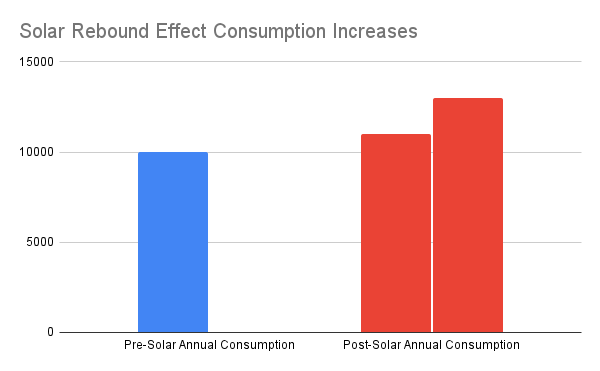There’s a phenomenon in the residential solar industry that causes headaches for solar homeowners and solar installers alike. Thanks to research from The Electricity Journal at Science Direct, we can finally put a name and numbers to the problem: The Solar Rebound Effect.
The Solar Rebound Effect was mentioned in a previous article. In this piece, we’ll explore its definition, how it happens, and how installers and homeowners can prepare for it.
Table of Contents
What is the Solar Rebound Effect?
The rebound effect has recently found its way to solar, but its history began in energy efficiency. The premise is that when homeowners adopt energy-efficient technologies, energy consumption increases because the more efficient appliance is used for longer periods.
The Solar Rebound Effect is based on empirical research showing that homeowners who adopt solar PV tend to increase their energy consumption after installing their PV system. Studies show an increase between 10% and 30% of pre-solar annual consumption and note those increases will decrease the effectiveness of the solar energy offset.

Why Does the Solar Rebound Effect Happen?
While there is not one clear cause for the Solar Rebound Effect, there are likely two main culprits: mindset changes and electrification.
- Mindset changes happen more often than not by accident or through a misunderstanding of how the PV system produces energy.
- Electrification happens on purpose and directly results from adopting a clean energy system.
Each has its unique characteristics and requires specific expectations on the front end.
Mindset Shifts
A gentle but continuous shift in the energy usage mindset can significantly and negatively impact energy consumption, and unfortunately, homeowners who adopt solar energy are not immune to it. Once someone installs solar, a thought tends to creep into their head, telling them, “The energy is free.”
Normally, it’s not some vast energy expenditure; it’s leaving lights in a room that would typically be turned off. It’s cooling the house by another few degrees in the summer and running the space heater a little longer in the winter. Small things add up to more energy used over time. We all occasionally make these changes, but they become a more significant issue when someone installs solar.
Solar sales reps sometimes mistakenly tell homeowners that they will “eliminate their power bill.” If a homeowner installs a PV system with the expectation of offsetting 100% of their energy, meaning the estimated production matched their previous year’s consumption, they expect a very low or non-existent electric bill. When homeowners start using more energy and receive a higher-than-expected electricity bill, they are upset and believe the system isn’t producing what it should.
In some cases, net metering credits can also be to blame, but a hard realization for many homeowners is that they simply might be using more power than they did before.
Electrification
Homeowners experiencing the Solar Rebound Effect because they electrified appliances in their home or added high-consumption items like hot tubs or EVs are less likely to call their solar installer to complain about their energy bills. However, they can still experience frustration due to misaligned expectations.
In general, homeowners who are adding electric appliances underestimate the consumption effect those appliances will have on their home, and that causes most of their frustration. Let’s take EVs, for example. The Electric Vehicle Council estimates that while there are many factors influencing the energy consumption of an EV, most homeowners see their energy bills increase by up to 50%.
If a person underestimates how much their consumption could increase from the new appliances or doesn’t expect an increase because electric appliances are “more efficient,” they’ll likely think that their solar panels aren’t producing enough or are broken.
How to Mitigate the Solar Rebound Effect
Properly setting expectations with the customer is the best way to prevent the rebound effect in the above scenarios. During the original sale and in post-PTO touch bases, successful solar companies will explain the rebound effect and be sure to warn customers of increased consumption. Make sure to drive home that the panels will only produce a finite amount of energy and were designed based on consumption now. If the home uses more power than the system was designed for, they may not get their intended result.
One of the most successful strategies is walking the customer through their future energy consumption at the time of sale. By aligning the goals for the system based on the homeowner’s current and future electrical footprint, such as the EV, electric stove, electric water heater, etc., a salesperson and homeowner are set up in a more transparent position.
Pairing systems with consumption monitoring also helps this conversation. By giving homeowners a way to track their energy consumption, you give them more responsibility and power to ensure they’re staying energy efficient. Some third-party units are available, and many inverter manufacturers build consumption monitoring into their systems.
Turning a Potential Headache into an Opportunity
The solar rebound effect can have negative consequences, but solar providers can turn them into opportunities.
By setting great expectations on the front end and having regular conversations with homeowners about their energy consumption backed by data from consumption monitoring, solar providers can build great relationships and reputations. Should those customers choose to add more panels to mitigate their increased consumption, you’ll be their first pick.
As always, if you’re adding solar panels or batteries to someone’s home or selling them solar and storage for the first time, check out the SI-30 products from Solar Insure.



